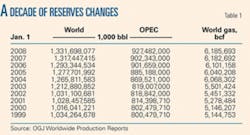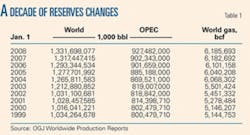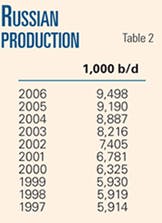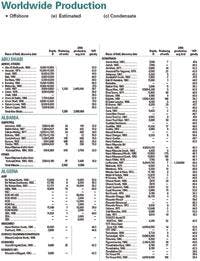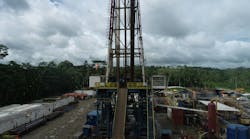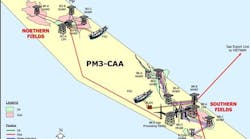Worldwide oil and gas reserves grew marginally from a year ago, and oil production declined slightly during 2007, according to Oil & Gas Journal’s annual survey.
New estimates of worldwide oil reserves total 1.33 trillion bbl, up 1.1% from previous estimates (OGJ, Dec. 18, 2006, p. 20). Gas reserves estimates total 6.185 quadrillion cu ft, nearly unchanged.
Oil reserves held by the Organization of Petroleum Exporting Countries are up a bit, as Angola’s inclusion boosted the group’s share of the world’s reserves. Angola joined OPEC at the beginning of the year. But total gas reserves held by OPEC members edged lower.
OGJ’s estimates of proved reserves are compiled from a survey of official sources. Many estimates are unchanged from the previous report because most countries do not assess their reserves annually.
Reserves changes
There were few major changes to individual countries’ oil and gas reserves reported this year. Most of the adjustments were small and due to production. Reevaluations and economics are also reasons cited for adjustments, especially in light of higher oil and gas prices.
The region with the largest percentage addition to reserves is the Western Hemisphere. The newest estimates of natural gas reserves in North America and Latin America climbed a collective 5.3%, while oil reserves estimates increased 1.6% from a year ago.
Canada’s gas reserves moved slightly higher, but its oil reserves are now a bit lower. The country’s conventional crude and condensate reserves are now estimated at 5.392 billion bbl, according to the Canadian Association of Petroleum Producers. The latest estimate of Canada’s oil sands reserves is 173.2 billion bbl.
The biggest regional decline in reserves is for Western Europe. Collectively, oil reserves across the region are estimated 10.5% lower than previously, and gas reserves estimates are down 5%. Norway’s oil reserves sank more than 12%.
The UK attributed its 7% decline in proved oil reserves and 14% decline in gas reserves to a combination of production during the year, reserves additions from new field developments, and reserves revisions in established fields.
Oil reserves for the Asia-Pacific region are up almost 3%, primarily due to upward revisions in Malaysia and Thailand. Malaysia’s reserves climbedoil up more than 2% and gas up more than 1%as a result of exploration, Petronas reported.
The newest reserves figures for Papua New Guinea show large downward revisions for both oil and gas. Collectively, gas reserves for the Asia-Pacific region declined 1% in spite of increases in Malaysia and New Zealand.
Total OPEC oil reserves climbed 2.7% with the addition of Angola this year. This puts OPEC’s oil reserves at 927.5 billion bbl, accounting for 69.6% of the world’s oil reserves. The organization’s gas reserves are now estimated at 3.15 quadrillion cu ft.
US reserves
Proved reserves of oil in the US declined, but US gas reserves increased from previous estimates, according to the US Energy Information Administration.
Down 3.6% from a year earlier, crude oil reserves at yearend 2006 were 20.972 billion bbl. Due to downward revisions and fewer new discoveries, the Gulf of Mexico federal offshore and Alaska reported 10% and 7% reserves declines respectively.
Utah reported the largest crude oil reserves increase, adding 78 million bbl, followed by Colorado and New Mexico. Total US oil production outpaced reserves additions, as operators replaced only 52% of production during 2006.
Total discoveries of crude oil were 577 million bbl last year, the majority of which came from field extensions in Texas, Alaska, the Gulf of Mexico federal offshore, and Montana, as well as in California, New Mexico, and Louisiana.
Gas reserves totaled 211.085 tcf, up 3.3% from a year earlier. Most of the gains, 21.778 tcf, were from extensions to existing gas fields.
New field discoveries were 409 bcf, and new reservoir discoveries in old fields added 1.155 tcf to total US gas reserves.
EIA reported that Texas led the US in gas reserves additions during 2006. The 9% increase was due to rapid development of Barnett shale reservoirs in Newark East field. Relatively high gas prices and advances in technology, including horizontal drilling and hydraulic fracturing, drove these reserves additions. Following Texas in gas reserves additions were Alaska and Utah.
Coalbed gas reserves declined 1% during 2006, accounting for 9% of US gas reserves. Production of coalbed gas was up 2% last year.
EIA also reported that US reserves of natural gas liquids increased 3.8% last year to 8.472 billion bbl, as operators replaced 138% of production with reserves additions.
Oil production
Worldwide production of crude and condensate declined 0.4% last year to average 72.36 million b/d, according to OGJ estimates.
The countries of the former Soviet Union led all other regions in 2007 production growth. Russia’s estimated production this year averaged 9.72 million b/d, up from 9.5 million b/d in 2006.
Africa was the second-fastest growing region with 2007 crude and condensate production up an estimated 3.3% from 2006. Angola, Sudan, and Tunisia posted output gains, while Nigeria’s average production declined about 2.4% this year because of political disruptions.
Western Europe is the region estimated to have posted the largest production decline this year. The region’s 6.4% production drop was led by a 10% decline in Norway and a 9% decline in Denmark. UK crude and condensate production is estimated to have declined nearly 2% this year.
Down almost 6%, Saudi Arabian output led the 2.6% decline in production in the Middle East, mostly due to OPEC output restraint. Meanwhile, combined production in the Asia-Pacific region was little changed, averaging an estimated 7.377 million b/d this year. Production in Indonesia slid, but New Zealand and Thailand reported increases for 2007.
With the addition of Angola, OPEC oil production is estimated to have climbed nearly 3% this year. Excluding Angola’s production from the organization’s 2007 production shows that all other members posted a collective 2.8% decline from 2006 output.
Crude and condensate production declined 1.1% this year in the Western Hemisphere. Venezuela’s 6.7% production decline led the region, while Mexico’s production slid 3.7%. US crude and condensate production held steady at 5.135 million b/d.
Click here to view a PDF of the Worldwide Look at Reserves and Production table from page 24 and 25.
OGJ subscribers can download, free of charge, OGJ Worldwide Report 2007 tables from the OGJ Online home page at www.ogjonline.com. Click “OGJ Online Research Center,” then “OGJ Subscriber Surveys,” then “Worldwide Production” or “Worldwide Refining.” Click to view the Worldwide Production Report 2007 and Worldwide Refining Survey 2007 in PDF format.
